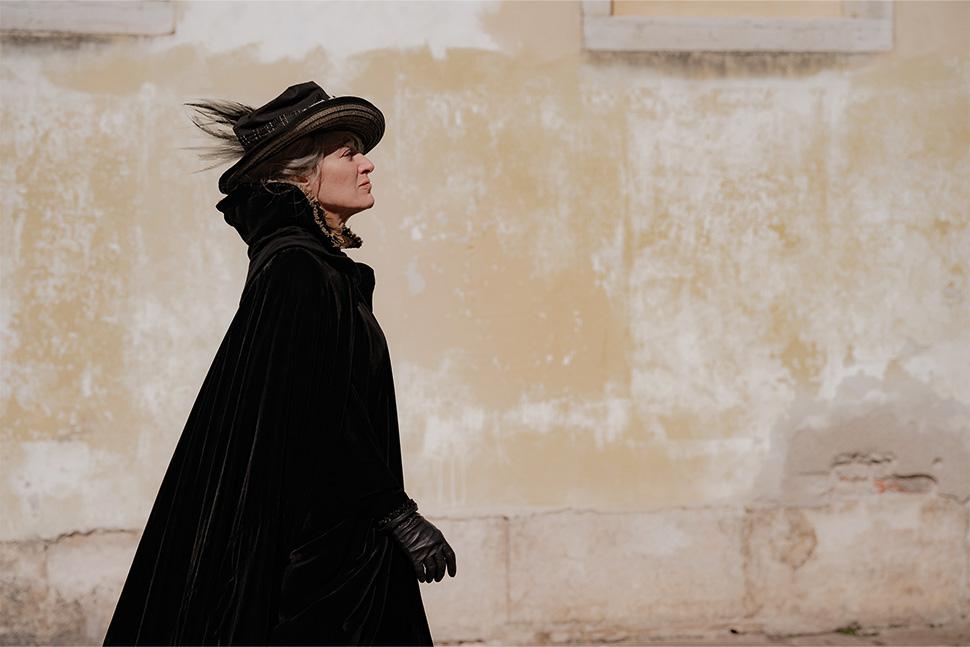Dust rises from a WW1 battlefield filled with toy soldiers as the curtain swishes open on Duse, Pietro Marcello’s (Martin Eden) handsome and deep-diving period film chronicling the last years of mythic stage actor Eleanora Duse (1858-1924).
Still revered as a symbol of modern theater a hundred years after her death, “La Divina” is brought to life by a charismatic, gray-haired Valeria Bruni Tedeschi — not as a suffering, ego-wounded diva à la Angelina Jolie’s Maria Callas, but as a caring, independent, mature woman whose intelligence and courage match her emotional faculties. Bowing in Venice competition, it meets modern audiences more than half way with a fascinating viewpoint on a powerful woman.
Embedding her life story in the rise of the emerging Fascist movement adds a great deal of gravitas to the film. It also attempts to set the record straight and show that Eleanora was a free-thinking political liberal, although her death was unjustly co-opted by the Nationalists and Mussolini’s movement for their dark cause. The screenplay by Marcello, Letizia Russo and Guido Silei addresses the backstory, too.
Importantly, the film is punctuated by newly colored archive footage that is almost shockingly lifelike. Silent, accusing images show weary soldiers returning from the front, milling urban crowds, cocky Black Shirts. The unexpected veracity and naturalness of this visual innovation lends the viewer new eyes with which to see the leering faces and haunting locations, while it puts the narrative in a broad historical context.
Though already in her sixties and sporting steel gray hair down to her waist, Eleanora is a tireless traveler. At her side is her gentlewoman companion, Désirée Von Wertheimstein, played by Polish actress Fanni Wrochna. A young Austrian, she is prim and by-the-rules, though with hints of an underground fire. For her Duse is a mother figure who elusively slips out of her protective grasp. Unpleasantly domineering, instead, is Eleanora’s grown daughter Enrietta (Noémie Merlant, Tár), who can’t wait to admit her to the safety of a sanatorium. (Her mother does cough a lot.)
But Eleanora makes her own decisions, thank you. The story begins with her strenuous visit to an Italian military camp and field hospital high in the mountains, arriving by cable car. Her brief salute to the troops is sincere and devoid of nationalist rhetoric. It has been ten years since she gave up the stage and she tells the men, “I don’t know if I’m an actress”, though “poetry is more powerful than arms.”
While she is at the camp, a small plane appears overhead and a murmur rises up. It is Gabriele D’Annunzio, the famous Futurist avant-garde poet, who has embraced a life of action and violence, as per the Futurist creed of modernism at all cost. He and Duse broke off a long romantic relationship in 1904, but still he drops a gift addressed to her from his plane. She hastily unloads the scarf on her entourage. The implication is she’s not that into him anymore, particularly as he has extolled the rise of Fascism and is a figurehead in the new Italy.
But economic reversals due to the war change many plans. To pay her debts, Eleanora agrees to go back to the stage and star in Ibsen’s The Lady from the Sea. Opening night at La Scala is a triumph and the celebrities in the audience include Sarah Bernhardt, who arrives nonchalantly with her wooden leg. Later, Sarah reminds her old friend Eleanora that a world catastrophe has occurred and the theater must adapt and change its focus. Eleanora tends to agree.
This leads to the financial disaster of her next play, Hecube in the Trenches, a Futurist cliché poorly written by a pompous playwright and produced on a shoestring using the last of Duse’s money. It is heckled on opening night and closes immediately.
Sinking under huge debts, Eleanora finally turns to her old flame D’Annunzio for help. He is now an orator for the Fascists and she believes he will put in a good word for her with the powers that be. So when she is summoned to appear before Benito Mussolini himself, and his government pays all her debts and grants her a pension, she lays it to the poet’s good offices. But she is deceived. In a final face-to-face with the Futurist, who is now very old and sick, two larger-than-life figures exchange their last words in a touching farewell.
The film is full of enjoyable performances by a cast that goes far beyond the standard for period pieces, notably Fausto Russo Alesi’s nuanced wit as D’Annunzio and Vincenzo Pirrotta in the Mussolini cameo. But as is only appropriate, Bruni Tedeschi gives the knockout performance. She inhabits the velvet cloaks of Duse with natural class, and her occasional spacy idealism is a good match for La Divina’s eccentricity.
Tech work is at a high level throughout as the story roams the northeast of Italy, through gloomy mountain churches with damaged frescoes to the romantic villa on a Venice canal where Eleanora and Désirée spend the closing months.
Director: Pietro Marcello
Screenplay: Letizia Russo, Guido Silei, Pietro Marcello
Cast: Valeria Bruni Tedeschi, Fanni Wrochna, Noémie Merlant, Fausto Russo Alesi, Edoardo Sorgente, Vincenzo Nemolato, with the participation of Noémie Lvovsky
Producers: Carlo Degli Esposti, Nicola Serra, Marco Grifoni, Benedetta Cappon
Cinematography: Marco Graziaplena
Editing: Fabrizio Federico, Cristiano Travaglioli, Alessio Franco, Luca Carrera
Production design: Gaspare De Pascali
Costume design: Ursula Patzak
Music: Marco Messina, Sacha Ricci, Fabrizio Elvetico
Sound: Denny De Angelis, Federico Cabula, Alessandro Feletti
Production companies: Palomar – a Mediawan company, Avventurosa, Rai Cinema, PiperFilm, Ad Vitam Films, Berta Film
World Sales: The Match Factory
Venue: Venice Film Festival (Competition)
In Italian
125 minutes





